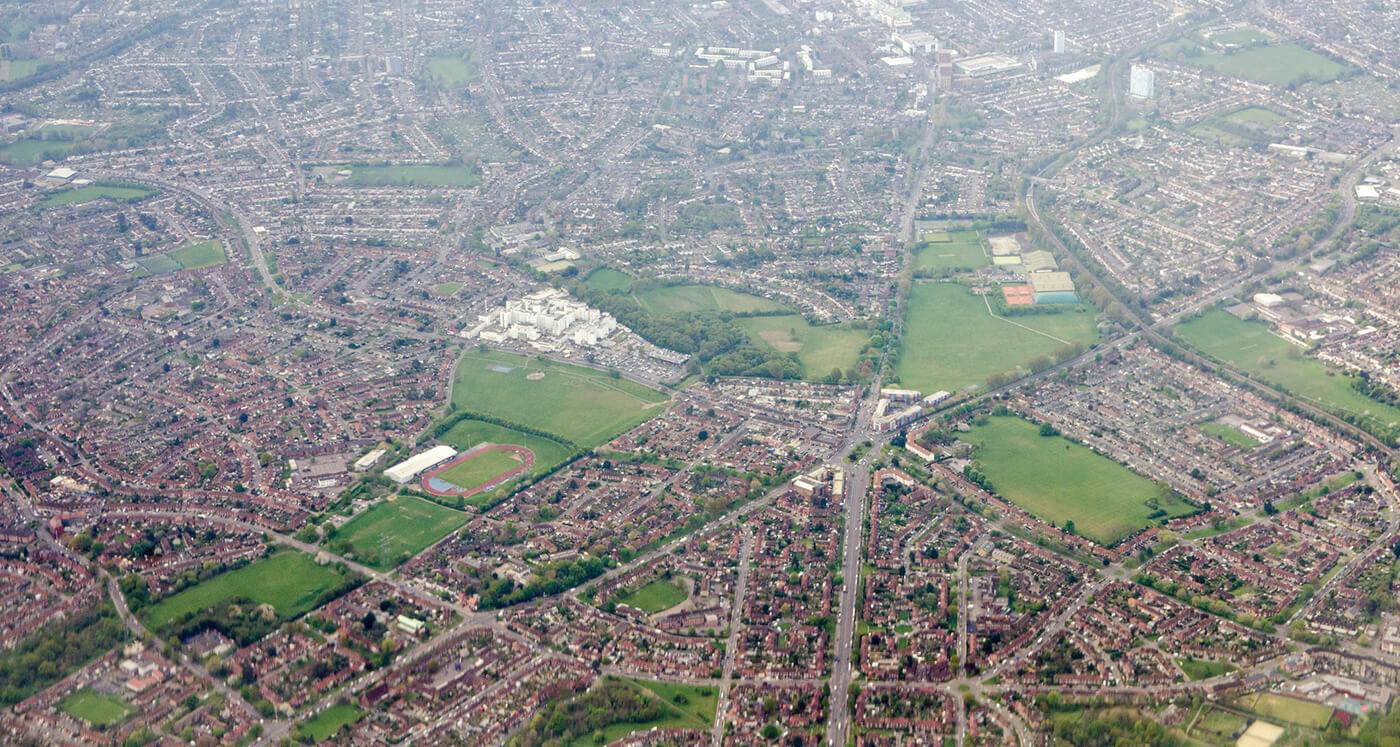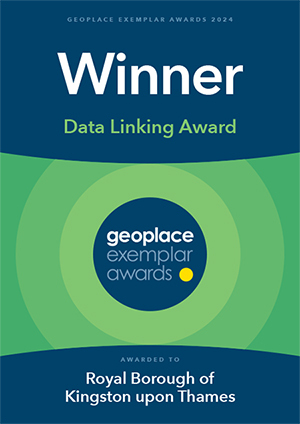The address management team at Royal Borough of Kingston upon Thames and Sutton Council is the winner of GeoPlace’s 2024 Data Linking Award for its work across the boroughs to ensure that address data was as accurate as possible prior to the 2021 census. The increase in data quality resulted in more accurate funding allocations and efficient services.

The Royal Borough of Kingston upon Thames and Sutton Council are both unitary authorities located in London, with a population of around 181,000 and 210,000 respectively. This case study will examine the steps taken prior to the 2021 Census review, to ensure their data was as accurate as possible, and outline how new properties were discovered as a result.

In early 2020, the Office of National Statistics (ONS) published information around the Census; this guide focused on helping local authorities with methods they could use to improve the information they held. Essentially, ONS established that in order to have as close to an entirely accurate representation of all properties within the borough in the then upcoming 2021 Census, authorities would need an accurate address index. The importance of recording a population accurately influences the future of the authority being funded correctly by central government, the resources it provides its citizens, and the knowledge of their demographic.
Engagement and communication were a fundamental step in this, and one key contributor to success came from identifying and sharing local community contacts.
The Challenge
There were a number of property types within Kingston and Sutton that had gaps within the data, either missing or not being accurately recorded. As a result, there was an impact on the accuracy of the overall address index. One example of this was the misrepresentation of the student population and where they lived i.e. student accommodation. With a distinct lack of detailed data around halls of residence being captured in the Local Land and Property Gazetteer (LLPG), the large student demographic was underrepresented as a result. Similarly, there were a large number of properties known to exist that simply weren’t recorded accurately, such as: Houses of Multiple Occupation (HMO’s), houseboats, sheltered accommodation and travellers sites. These were confirmed by the HMO officers in the boroughs.

There were a number of methods used to identify the properties that had been missed, all of which proved successful as a result of good communication. Contact with the licencing team allowed the discovery of HMO discrepancies. Elements such as the normal Street Naming and Numbering process also turned up inconsistencies; one example of this being canvassing. The 1918 Representation of the People Act and everyone’s right to vote identified a series of HMOs, which contradicted the gazetteer and planning records. The discovery of these properties highlighted the lack of synchronisation within the data, sparking further conversations, investigations and ultimately allowing them to be resolved. The extent of these differences triggered a desire within those working on the project to delve further, to fully understand the root of the issue.
One example to highlight this process would be the case of a street within Kingston that held a series of flats above a line of shops, known to be student accommodation. After communication and research, it transpired that there were a total of 40 newly discovered HMOs on the street. From a local authority service provision point of view, these were an additional number of properties and residents that had not been previously been accounted for, meaning service delivery was perhaps at a level which was overextended for the actual numbers on the ground.
Another level of challenge came from not a lack of existing property knowledge, but a lack of accurately recorded detail. Student accommodation blocks were held singularly as a hall of residence. This meant there was no definition of any specific block, any rooms, or of any further detail about the address. These properties being correctly accounted for within the gazetteer as individual residences allows for opportunities for better interaction within those communities. As a result, these residents are now able to vote, public services such as the emergency services have visibility of their address, and local government services can be planned and deployed accordingly.
From the perspective of outcome-based decision making, the justification of services such as an increase in school placements, or an increased number of doctors’ surgeries can occur as a result of a more substantial population demographic being captured and represented. Without the correct demographic statistics, there is a distinct lack of accurate funding to enable an authority to act sustainably.

The Process
Communication was the fundamental factor in enabling this process to succeed. Regular team planning meetings, held by the Address Management Team, as well as frequent question asking drove the project forwards.
The first step was to initially split this into separate tranches of work. The work was divided logically into different categories: HMOs, halls of residence, sheltered accommodation, travellers sites and houseboats.
- Student Accommodation
As probably the most impactful category of missed data, Student Accommodation was an important area to accurately capture. The large student population in the authority has a large impact on the services the authority is required to provide. Ensuring services are sufficiently funded to account for this was therefore a priority. They were able to engage directly with universities to determine if they held their own accommodation site plans, and also find the third-party partners they may hold contact information for. Student accommodation, as a parent classification, enabled the authority to trawl back through Street Naming and Numbering records for sites that hadn’t been held correct historically, and as a result try and work out whether anything had been done in the past 20/30 years.
- Travellers Sites
The challenge here is that there is no established single point of contact for travellers sites. Councils historically had a traveller liaison officer, so initially research was undertaken to identify these points of contact, to try and find as much information as possible. In some cases, this revealed previous spreadsheets, but sometimes the majority of the work had to be undertaken by the authority recording this data themselves.
Different teams were able to assist in some aspects, for instance electoral registration or enforcement teams contributed information if they had it. There is frequent under representation of the population of traveller sites due to their transient nature. Critically, the number of young children potentially being missed would impact the school funding and placements.
The key to success within this sector was to establish a line of contact. The route of communication between different teams and members of the council varied, but overall the engagement between departments and pursuit of accuracy led to success. The weight of work for identifying these differences was reasonably balanced. While validating student accommodation information was much more easily available, the majority of the work comes in actually adding this content into the gazetteer. Whereas, the majority of the work identifying an individual HMO comes from its investigation of the property and validating its existence.

- Identifying and Fixing Discrepancies
In addition to drawing from past council spreadsheets or contacts, properties were also identified through a number of other routes. The authority receives a high volume of queries from residents on various property related matters via email, or web forms, ranging from questions about their property, complaints, requests for waste collection, school place queries etc. Sometimes, in looking into these cases, properties of interest can be discovered such as suspected HMOs, or illegally built properties (those which cannot be found within the LLPG).
As a result, they can then be passed on to the necessary department for investigation and the data can be updated accurately. Whichever sources provided the information of the suspected discrepancy was the first line of contact to be checked. Once it had been established that the property was in fact an HMO, it was then added to the gazetteer in the usual manner.
When updating the gazetteer with these suspected new properties, there were a number of steps taken. The team established a simple but highly effective method of tracking queries by utilising a shared spreadsheet with HMO officers, listing known HMOs, suspected HMOs and a list that the HMO officer believed they had. Essentially, a large spreadsheet of HMOs to be checked was created. Some were already in the gazetteer, while some were complete unknowns.
The process of establishing whether these were in existence then began, following a line of communication and visits. Thorough checks were undertaken as to whether the information provided was true, via multiple sources and lines of communication.
There was a lot of proactive crosschecking. For instance, taking an extract of council tax and comparing it to electoral registration to compare the numbers of people against the amount of registered voters. Cross referencing is the key to linking up all this data, and as a result of a project previously surrounding matching council tax and the electoral register, the authorities had a lot of clean data to work with. HMO data was taken to establish the number of rooms/people, which was cross matched against council tax and electoral registration data to provide a sense check of whether the numbers aligned. Initially these reports were done using spreadsheets and graphs, but now is centralised and processed using Safe’s software - FME
The Result
There were a number of significant outcomes as a result of this work. 3,000 additional properties were discovered, Kingston possessing significantly more than Sutton. These were comprised of HMOs and Student Accommodation. House boats were also a notable change, from initially holding 4 registered, to eventually holding around 50. There were a number of significant changes:
- 93 blocks of flats created
- 501 cluster flats created
- 3,459 classifications changed from flats to HMO rooms or HMO room to flats so far
- 2 blocks of flats deleted as have never existed
- 5 cluster flats deleted as have never existed
- 5 HMO rooms deleted as have never existed

As expected, public services were broadly impacted as a result of this change. The Electoral boundary review was due to start regardless, however the work undertaken aided in the decision making of additional wards with all the extra properties picked up. Three entirely new wards were created as a result.
This accommodated for newly detected properties and the newly accounted for population. All ward boundaries were amended, but the number of councillors remained the same at 48. Councillor numbers in some wards reduced from three to two, and increased in others from two to three. The ward amendments enabled Kingston council to balance the number of electors across the wards, proportionally. Residents are represented through newly appointed elected members, across the additional wards created.
The number of doctors surgeries and doctors’ capacity to serve the population sufficiently would also have been largely impacted. The influence on emergency services, and the coverage they provide would have been altered. Schools and education would have been considered, and the implication of additional school places. The reality behind these services are undoubtably that these changes would have been occurring anyway, the difference being they simply would have been insufficiently funded. Whilst there was a lack of a physical influx of population, the developed knowledge of the people that require provisioning for allowed the improvement of funding and sufficient service allocation.
The strategic planning process and long-term planning is also based upon demographic and population. The development of large housing estates is partly approved or denied on the basis of population and enhancements within areas are impacted by this data. Even down to elements such as traffic sensitivity of roads and how impacted these streets are; having discovered an additional 3,000 properties impacts these patterns too as it places additional load / usage on the network which was previously unaccounted for.
Another benefit was reflected in the response to the digital Census that went out. The figures that came back from both Kingston and Sutton achieved almost a 96% response rate. This figure wouldn’t have been anywhere near as high without the work undertaken to improve the data.
Conclusion

In conclusion, the Census review work undertaken at Kingston and Sutton speaks volumes to what can be achieved with effective communication when reviewing the accuracy of data within an authority. The results they have accomplished and the impact it has had on authority services is remarkable.
The higher level of representation in both the overall demographic, as well as on an individual basis, holds no end of benefits and possibilities. Three newly formed wards, the possibility for political representation and voice, the benefit of a correctly funded authority with accurate services has a massive impact across the authority
The improvements reach beyond just the physical data changes. Before this piece of work, the regulatory licensing team were very siloed, but now take daily updates from the gazetteer, which is an obvious development to their data, and by result, their work. Previously they held the data on two different systems, one of which only held a 15% address match to the gazetteer.
Without this work, the return rate in terms of the Census would definitely not be 96%, electoral services would not have as many people nor properties on their canvas list, council tax wouldn’t have as many properties, and there would be nowhere near as many HMOs as they have now. All the demographics and statistics would have been wrong. The forecasting and analysis of the information that the authority has now is that much more accurate and developed now, than it was previously.
The key to success for this project undoubtedly communication between departments. The most invaluable asset is to have someone within the project team with tenacity and a good knowledge of the different departments and who to speak to within each.
For an authority without those established relationships, speaking to a Data Cooperation Agreement elected Chair or regional Chair is a good first step in starting to build these relationships. From the nature of these roles, good communication and interpersonal interaction is key, and so starting to build this network is beneficial.
As previously mentioned, this is an ongoing data process within Kingston and Sutton. The data is refreshed on a quarterly basis using FME, with a view to also trying to look at using this for food licensing and alcohol licensing. Once these teams are using the UPRN and including them in their work, it is easily then pulled back into the gazetteer, which then goes on to help the gazetteer further and the cycle of proactively detecting anomalies and discrepancies can occur.



